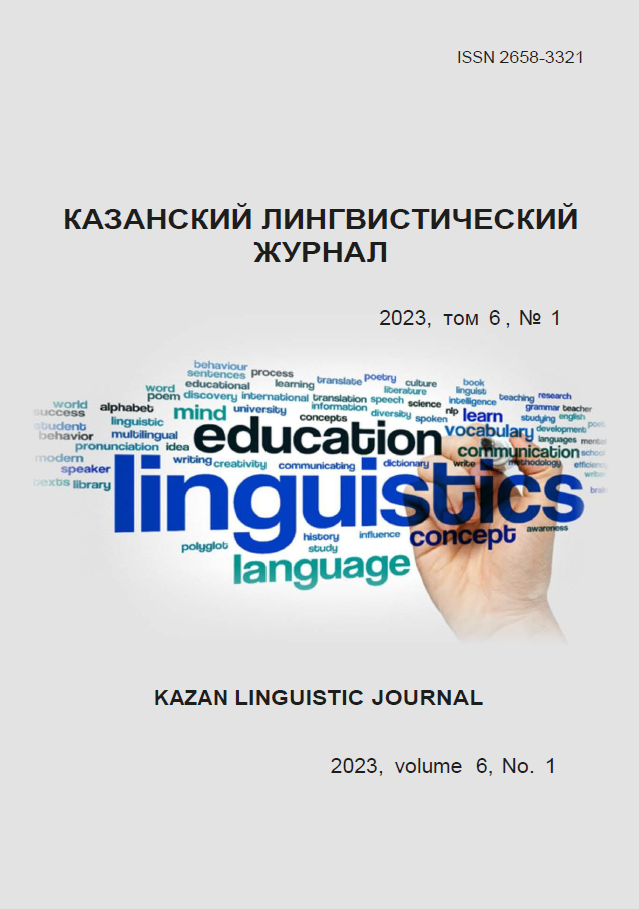About the difference in the use of constructions with participles -DIĞI / -ACAĞI (adjective-verbs) and Truncated infinitives -MASI (noun-verbs) in Turkish
https://doi.org/10.26907/2658-3321.2023.6.1.134-147
Keywords:
Turkish language, adjective-verbs, participles, truncated infinitives, noun-verb, verbal noun, detailed parts of the sentenceAbstract
This article offers the author's interpretation of the use of specific complex grammatical constructions of the Turkish language, usually causing significant difficulties in studying them with Russian-speaking students. We are talking about participles -dığı / -acağı (adjective-verbs – “sıfat-fiiller”) and truncated infinitives -ması (noun-verbs / verbal nouns – “isim-fiiller”).
The purposes of the study undertaken are to compare the interpretations of Turkish and Russian linguists; on the basis of morphological, morphemic, semantic and syntactic methods of analysis, to find out the origin and essence of adjective-verbs -dığı / -acağı and truncated infinitive -ması in Turkish; correctly describe them in close terms of Russian grammar; find out the logic of use in Turkish and of translation into Russian.
As a result, it managed to find out that -dığı / -acağı / -ması structures undoubtedly have a high degree of specificity and unusual for Russian-speakers both in terms of the correct understanding of their essence and morphological correspondence and practical application. However, it turned out to be possible to find for them in the Russian language semantically and morphologically close parts of speech and syntactic constructions. Also to describe the main logic of their use as detailed members of the proposal (subject, predicate, definition, object, aderbial modifier) and to formulate proposals for Russian Turkologists by changes in approaches to teaching these topics.
References
References
Özkan M., Tören H., Esin O. Written and Oral Expression of the Turkish Language in higher education. Expanded 3 editions. Istanbul: Filiz bookstore; 2013. 999 pp. (in Turkish).
Muharrem E. Knowledge of the Turkish Language. For the Departments of Turkish Language and Literature of the Faculties of Literature and Education. Istanbul: Bayrak publishing house; 2011. 407 pp. (in Turkish)
Gülsevin S. -DIK / -(Y)ACAK + On the Use of the Suffix of Interest in the Subjects of the + October Possessive Constructions. TEKE: International Journal of Turkish Literature Culture Education. 2015. 4(3): 889–898. (in Turkish)
New Hittite 1. Basic. Turkish For Foreigners. Textbook. Editor Prof. Dr. N. Engin Uzun. Ankara: Ankara University Press. TÖMER; 2017. 200 p. (in Turkish)
New Hittite 2. Medium. Turkish For Foreigners. Textbook. Editor Prof. Dr. N. Engin Uzun. Ankara: Ankara University Press. TÖMER; 2008. 196 p. (in Turkish)
New Hittite 3. High. Turkish For Foreigners. Textbook. Editor Prof. Dr. N. Engin Uzun. Ankara: Ankara University Press. TÖMER; 2009. 194 p. (in Turkish)
Kuznetsov P.I. Textbook for Turkish Language. In 2 parts. Part. 1. The Beginner’s Course. 6th edition, corrected. Moscow: AST: East – West publ.; 2007. 473 p. (in Russian)
Kuznetsov P.I. Textbook for Turkish Language. In 2 parts. Part 2. The Final Course. 6th edition, corrected. Moscow: AST: East – West publ.; 2007. 510 p. (in Russian)
Kuznetsov P.I., Shcheka Y.V. Textbook for Turkish Language. In 2 parts. Part. 1. The Beginner’s Course. 5th edition. Moscow: Eastern Book publ.; 2010. 592 p. (in Russian)
Shcheka Y.V. Practical Grammar of the Turkish Language. Textbook. Moscow: AST: East – West publ.; 2007. 666 p. (in Russian)
Genish Eyup. Grammar of the Turkish Language. Vol 2. Moscow: LKI Publ.; 2008. 352 p. (in Russian)
Kaytukova E.G. Turkish Language. Self-instruction Book. 2d edition, corrected. Moscow: Jivoy yazyk publ.; 2012. 212 p. (in Russian)
Kaytukova E.G. Turkish Language. Reference Book for Grammar. Moscow: Jivoy yazyk publ.; 2007. 224 p. (in Russian)
Podlesnaya Y., Paliy E. Turkish Language. Complete course of the Grammar. Reference Book. 1st edition. Kiev.: Sky Horse; 2020. 336 p. (in Russian)
Ümit A. The Devil Is Hidden in the Detail. İstanbul: Doğan Kitapçılık AŞ; 2003. 107 p. (in Turkish)






